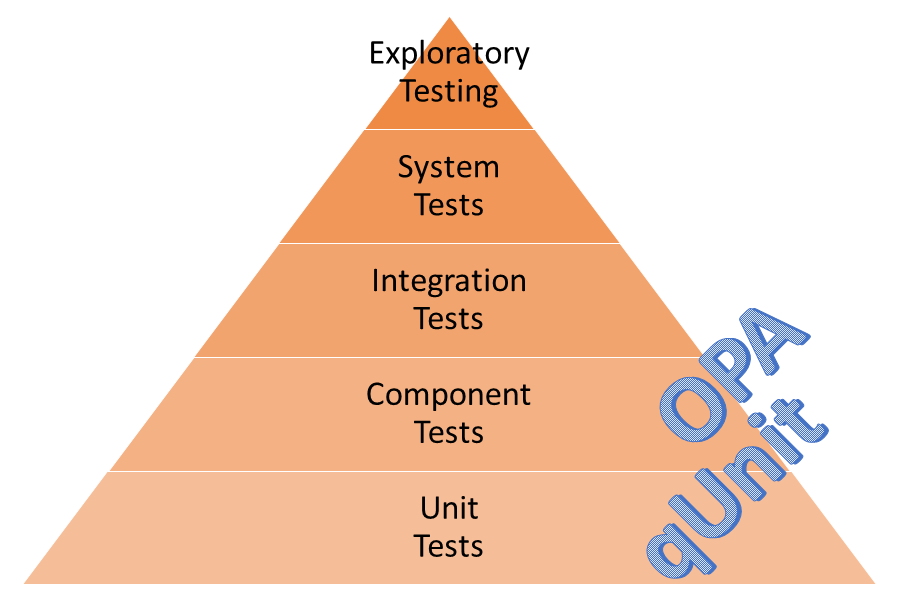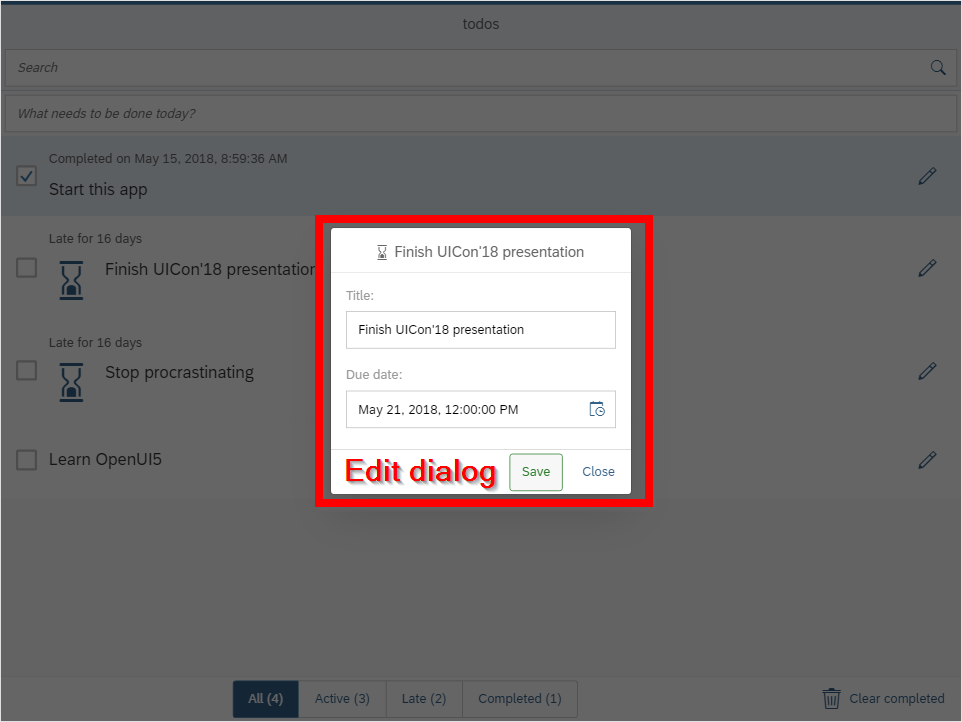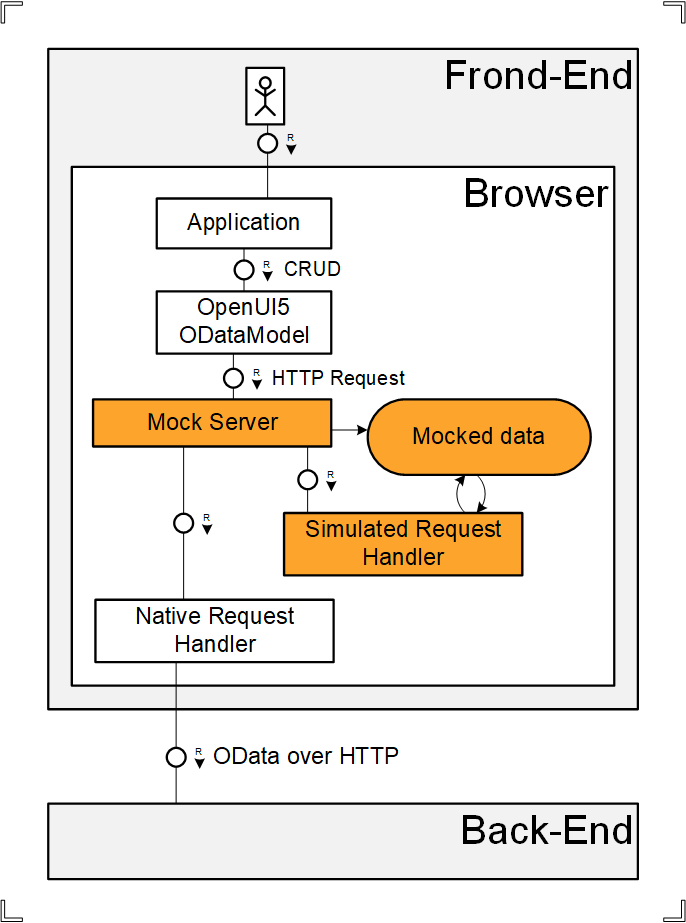A journey with OPA
Presented by Arnaud Buchholz
Presentation made with Reveal.js


Agenda
Sample application
- A simple todo list
- Developed to illustrate the OPA concepts
- 100% coverage
- Continuous Integration builds
Why Automated Testing?
If it's not tested, it doesn't work
Need I say more?
Automated vs manual testing
As the code complexity grows, it takes more and more time and/or resources to test the software manually.
The only sustainable solution is to automate the tests and have them run fast.
Some drawbacks of automated testing
It takes too much time
Some Product Owners...
This is a short term vision of automated testing: by reducing the number of bugs and maximizing the quality, you end up doing more features and less bug fixing.
Go slow to go fast
Some advantages of automated testing
Code never lies, comments sometimes do
Ron Jeffries
Automated tests ensure the proper documentation of the software: they showcase the application features.
Tests secure future code, enabling fast non-regression testing.
Unit testing vs Integration testing

Maximize unit testing: they must be fast and they ensure code modularity.
Leverage integration testing: check the happy path then edge cases.
Assessing test coverage
There are many ways to measure the tests coverage:
- Number of scenarios tested
- Number of acceptance criterias tested
- Code coverage
Don't forget the The Pareto principle. (a.k.a. the 80 / 20 rule)
Limits of code coverage
Code coverage gives you insights on which lines of code were executed. However, it does not mean that all scenarios were executed.
function divide (dividend, divisor) {
return dividend / divisor;
}
assert(divide(2,2) === 1);
Experiences feedback
After one year working with OPA tests, I changed my mind completely concerning OPA.Roger Knop
It is a great opportunity to verify the robustness and quality of the UI5 developments.
At the beginning it is hard to start, with the time it becomes much more faster to develop OPA tests.
Experiences feedback
[...] App seems to be quite stable. The effort for OPA testing (especially at the beginning of the project) pays out! A good example is the Variant Management of the GanttChart [...]. At a certain point in time we thought everything would have been covered. But due to existing OPA tests we figured out, that some functionalities were still missing [...].Maximilian Rupp
Experiences feedback
From my expierence in other projects I already knew the value of testing. But we never did testing to that extent. So developing a new feature was really half implementing the functionality half writing tests. Which was quite some effort and sometimes a challenge. But along the way it really helped us discover errors, weak points and unforseen side effects. And in the end the quality stands for itself.Pascal Wasem
OPA Overview
One Page Acceptance Tests
- UI behavior testing
- JavaScript based
- Tightly integrated with UI5
- Asynchronous with active polling mechanisms
- Enables Test-Driven Development through abstractions
Compared to other automation frameworks
Selenium, Marionette or Puppeteer are framework agnostic, one must rely on the generated HTML to code automation (IDs, CSS selectors...).
OPA is designed by and for UI5 developers: one manipulates UI5 controls.
What is OPA?
OPA is a set of tools used to automate and validate UI (and it comes with backend mocking).
Tests are organized in Journeys, based on Pages to abstract the UI, and readable.
An example of one OPA test
opaTest("should remove completed items", function(Given, When, Then) {
// Arrangements
Given.iStartTheApp();
// Actions
When.onTheAppPage.iEnterTextForNewItemAndPressEnter(S_NEW_ITEM_TITLE);
When.onTheListOfItems.iSetTheItemToCompleted(S_NEW_ITEM_TITLE);
When.onTheAppPage.iClearTheCompletedItems();
// Assertions
Then.onTheListOfItems.iShouldNotSeeAnyItemTitled(S_NEW_ITEM_TITLE)
.and.iTeardownTheApp();
});
Executing OPA tests
Limits of OPA
- Designed to test one UI5 application
- Not designed to test backend
Pages & Journeys
Pages
They are used to abstract UI elements
Pages Examples

Pages Actions & Assertions
- onTheListOfItems
/* ... */ When.onTheListOfItems.iSetTheItemToCompleted(S_NEW_ITEM_TITLE); Then.onTheListOfItems.iShouldSeeTheNewItem(S_NEW_ITEM_TITLE); /* ... */ - onTheFilterButtons
/* ... */ When.onTheFilterButtons.iClick(filters.COMPLETED); Then.onTheFilterButtons.iShouldSeeTheButtonCount(filters.ALL, 4); /* ... */
Pages Examples

Pages Actions & Assertions
- onTheEditDialog
/* ... */ Then.onTheEditDialog.iShouldSeeTheTitleField(); When.onTheEditDialog.iClickClose(); /* ... */
Pages implementation
sap.ui.define([
"sap/ui/test/Opa5"
], function(Opa5) {
Opa5.createPageObjects({
onAbstractNamePage: {
/*baseClass: ClassOfferingCommonHelpers*/,
actions: {
iExecuteAnAction: function() { return this.waitFor(/*...*/); },
/*...*/
},
assertions: {
iCheckAnAssertion: function() { return this.waitFor(/*...*/); },
/*...*/
}
}
});
});
Makes an extensive use of this.waitFor
Journeys
- Relying on pages' methods, they describe the user experience within the application
- A journey is composed of tests
- Each test follows the pattern
- Given: setup the initial state of the test
- When: execute actions
- Then: check assertions
Journey implementation
sap.ui.define([
"sap/ui/test/opaQunit"
], function(opaTest) {
QUnit.module("Journey name");
opaTest("Test name", function(Given, When, Then) {
Given.iStartMyApp();
When.onAbstractNamePage.iExecuteAnAction()
.and.iExecuteAnotherAction();
Then.onAbstractNamePage.iCheckAnAssertion()
.and.iTeardownMyAppFrame();
});
opaTest("Test name 2", function(Given, When, Then) {/*...*/});
/*...*/
});
Loading pages & journeys
- Ensure qUnit is loaded
- Load OPA, pages & journeys
- Start
sap.ui.require([
"sap/ui/test/Opa5",
/* pages */
/* journeys */
], function(Opa5) {
Opa5.extendConfig({
/* Default settings */
});
QUnit.start();
});
Anatomy of waitFor
Presentation of waitFor
- Main entry point to synchronize tests with the running application
- Locate and interact with UI5 controls
waitFor is asynchronous
waitFor-based members fill an execution queue
You can wait on the end of this queue using
sap.ui.test.Opa5.emptyQueue
Synchronization in asynchronous tests
Since the test function is executed before the application is started,
waitFor is required to synchronize.
For instance, to add a breakpoint:
// Actions
When.onTheAppPage.iEnterTextForNewItemAndPressEnter(S_NEW_ITEM_TITLE);
When.onTheListOfItems.iSetTheItemToCompleted(S_NEW_ITEM_TITLE);
When.waitFor({
success: function() {
debugger;
}
});
When.onTheAppPage.iClearTheCompletedItems();
waitFor options
- waitFor offers a large set of options
- They can be grouped and sequenced:
- (Configuring) timeout
- Finding
- Filtering
- Checking
- Interacting
- Reporting
- (Configuring) autoWait
Configuring - timeout
- timeout decides of the maximum waiting time (we use 15s)
- pollingInterval can be changed (defaulted to 400ms)
Finding
- id
- controlType
- viewNamespace & viewName
- searchOpenDialogs can be combined only with controlType
iEditTheItem: function(sTitle) {
return this.waitFor({
controlType: "sap.m.ObjectListItem",
/* ... */
});
}
No criteria means all controls
Polling until at least one control is found or timeout
Filtering (matchers)
Given the resultset of previous step
iEditTheItem: function(sTitle) {
return this.waitFor({
controlType: "sap.m.ObjectListItem",
matchers: [new Properties({
title: sTitle
})],
/* ... */
});
}
Polling until remaining results or timeout
Checking (check)
Given the resultset of previous step- Accept or reject all results
iShouldNotSeeAnyItemTitled: function(sTitle) {
return this.waitFor({
controlType: "sap.m.ObjectListItem",
check: function(aItems) {
return aItems.every(function(oItem) {
return oItem.getTitle() !== sTitle;
});
},
/* ... */
});
}
Polling until truthy or timeout
Interacting (actions)
Given the resultset of previous step
iSetTheTitleTo: function(sTitle) {
return this.waitFor({
id: "title",
actions: [new EnterText({
text: sTitle
})],
/* ... */
});
}
Reporting (success / error / errorMessage)
- Final step of the waitFor, receives resultset
- Avoid testing controls' state in success function
- Can chain to a subsequent waitFor
iShouldSeeAGivenNumberOfItems: function(iCount) {
return this.waitFor({
controlType: "sap.m.ListBase",
matchers: [new AggregationLengthEquals({
name: "items",
length: iCount
})],
success: function() {
Opa5.assert.ok(true, "The list shows " + iCount + " items");
},
errorMessage: "The list doesn't show " + iCount + " items"
});
}
Configuring - autoWait
- Not enabled by default
- When enabled, waitFor monitors pending tasks
requests, timeouts, promises, UI navigation...
and includes the Interactable matcher
Controls states are tested to check that they are 'available' and 'interactable' - Use sap.ui.test.Opa5.extendConfig to set it globally
- Can be turned off in a specific waitFor
For instance if you want to check that a button is disabled
Configuring - visible
- To find controls that are not visible from a UI5 point of view
// iShouldNotSeeTheField(sId, sName)
return this.waitFor({
autoWait: false,
visible: false,
id: sId,
matchers: [new Properties({
visible: false
})],
success: function() {
Opa5.assert.ok(true, "The " + sName + " field is *not* displayed");
},
errorMessage: "The " + sName + " field is displayed"
});
Mocking Backend
The need for a backend
When the application has a backend counterpart, it can't run without being connected to it.
However, tests have to rely on a stable dataset and some features might be dangerous.
Introducing the MockServer

The MockServer is a software component that captures AJAX requests and either answer them or let them reach the backend.
Configuring the MockServer
- It requires the metadata to know the entities and relationships exposed by the ODATA service
- It initializes the entity sets by generating them or loading JSON files
_oMockServer = new MockServer({
rootUri: "/odata/TODO_SRV/"
});
_oMockServer.simulate("model/metadata.xml", {
sMockdataBaseUrl: "model/"
});
_oMockServer.start();
MockServer entities
At any time, one can manipulate the entities
var aExisting = _oMockServer.getEntitySetData("TodoItemSet"),
sGuid = "0MOCKSVR-TODO-MKII-MOCK-00009999";
// Adding a new entity
aExisting.push({
"Guid": sGuid,
"Title": "Generated",
"Completed": false,
"DueDate": "/Date(" + new Date(2099, 11, 31).getTime() + ")/",
"__metadata": {
id: "/odata/TODO_SRV/TodoItemSet(guid'" + sGuid + "')",
uri: "/odata/TODO_SRV/TodoItemSet(guid'" + sGuid + "')",
type: "TODO_SRV.TodoItem"
}
});
_oMockServer.setEntitySetData("TodoItemSet", aExisting);
Default MockServer hooks
By default, the MockServer hooks a lot of
ODATA operations :
- $batch
(transparently split into individual requests and consolidates results) - Create, Read, Update and Delete
- Query parameters: paging, filtering, sorting
- Resolving navigation properties
One level only
But function imports are not supported
Altering the MockServer hooks
An hook is defined with:
- method: GET, POST, PUT...
- path: a regexp matching the API URL
Using capturing group, you can extract url parameters - response function: where the behavior is implemented
Altering the MockServer hooks
var aRequests = _oMockServer.getRequests();
aRequests.push({ // Creation of a todo list item
method: "POST",
path: CONST.OData.entityNames.todoItemSet,
response: function(oXhr) {
/* ... */
// Initialize some fields
var oBody = JSON.parse(oXhr.requestBody);
oBody[CONST.OData.entityProperties.todoItem.completed] = false;
oBody[CONST.OData.entityProperties.todoItem.completionDate] = null;
oXhr.requestBody = JSON.stringify(oBody);
return false; // Keep default processing
}
});
_oMockServer.setRequests(aRequests);
Adding new MockServer hooks
This is how function import can be implemented
// Clear Completed
aRequests.push({
method: CONST.OData.functionImports.clearCompleted.method,
path: CONST.OData.functionImports.clearCompleted.name,
response: function(oXhr) {
/* ... */
oXhr.respond(200, {
"Content-Type": "application/json;charset=utf-8"
}, JSON.stringify({
d: oResult
}));
return true; // Skip default processing
}
});
MockServer hooks Tips & Tricks
- The MockServer does not need to be 100% equivalent to the backend
- Newly added hooks are executed first (LIFO)
- You may also use attachBefore or attachAfter callbacks triggered before or after request processing
Key Take-Aways
If it's not tested, it doesn't work
- OPA is designed to automate and validate UI5 applications
- Asynchronous with active polling
- Define pages to abstract and componentize UI
- Keep the journeys readable
- Use MockServer to simulate the backend
-
 training-ui5con18-opa
training-ui5con18-opa